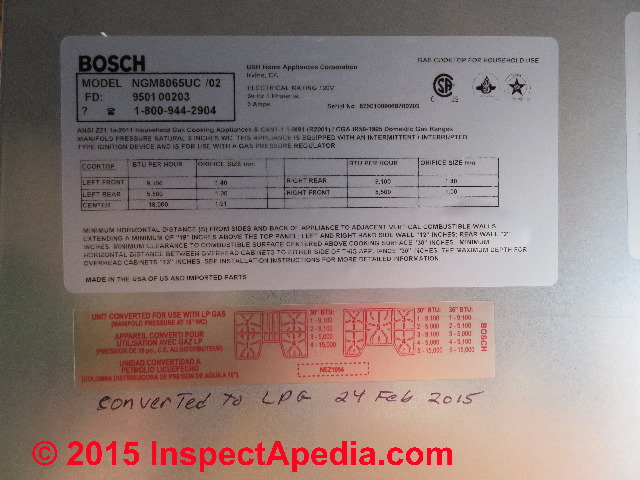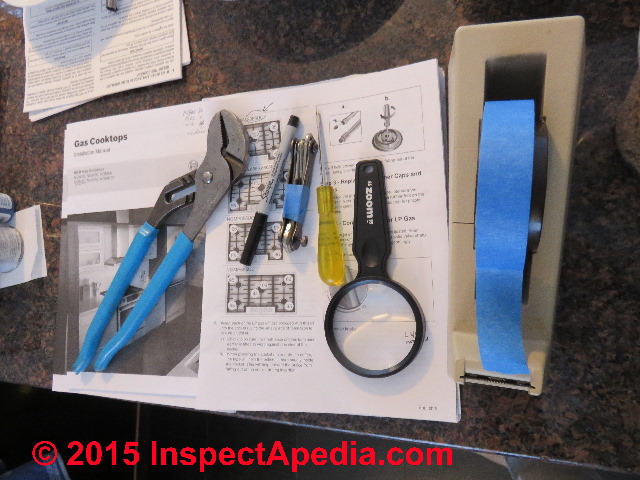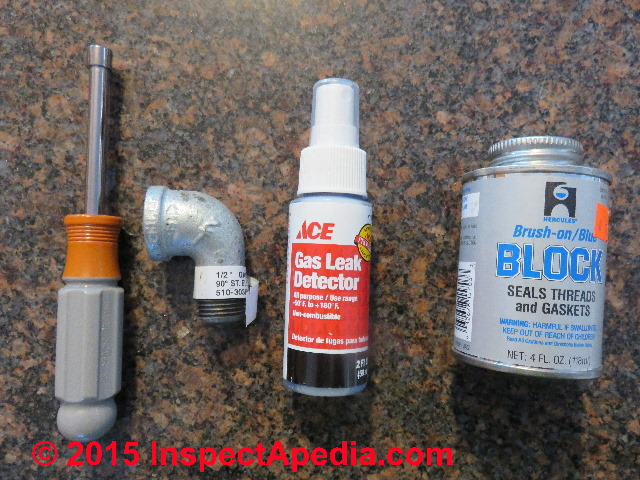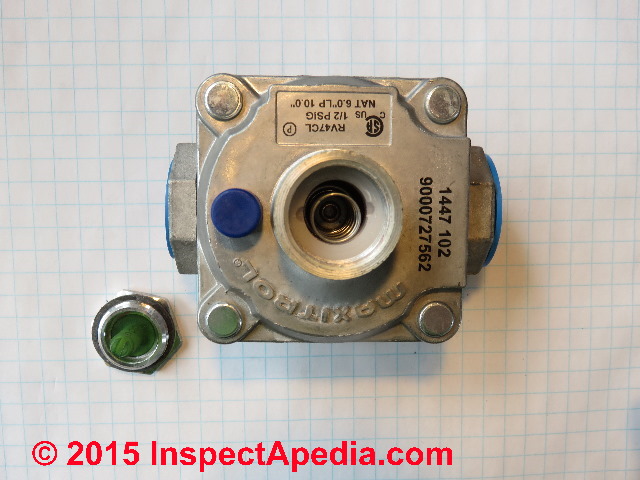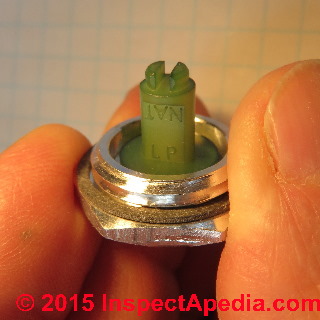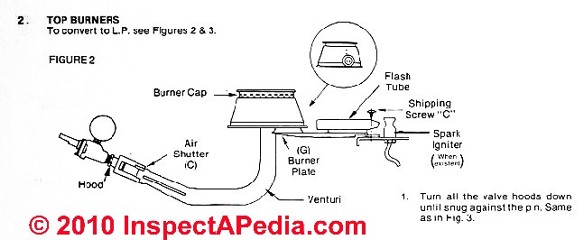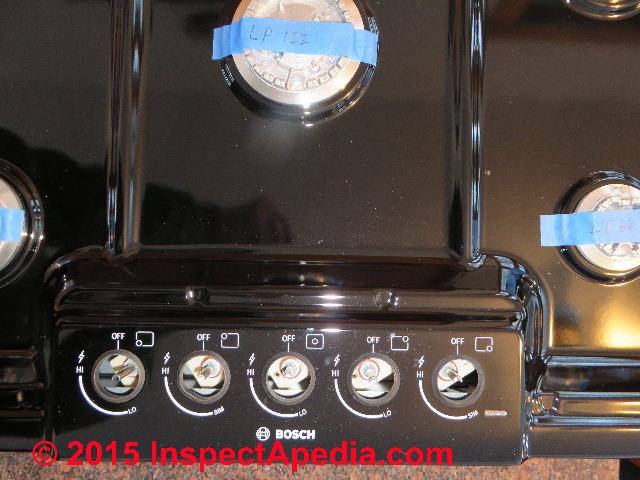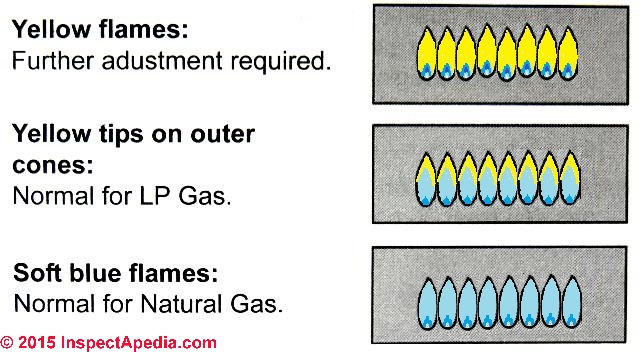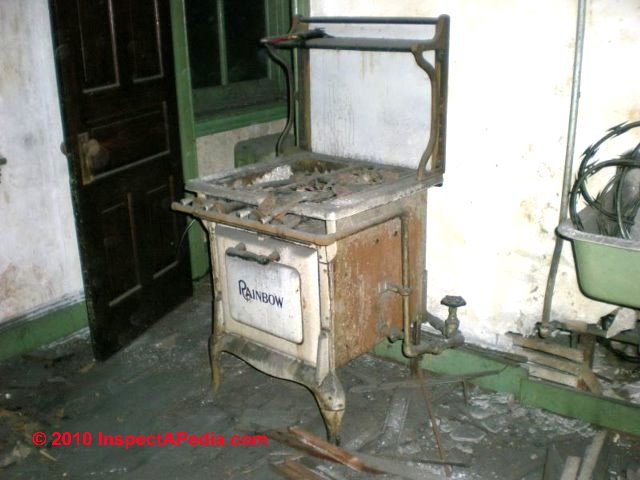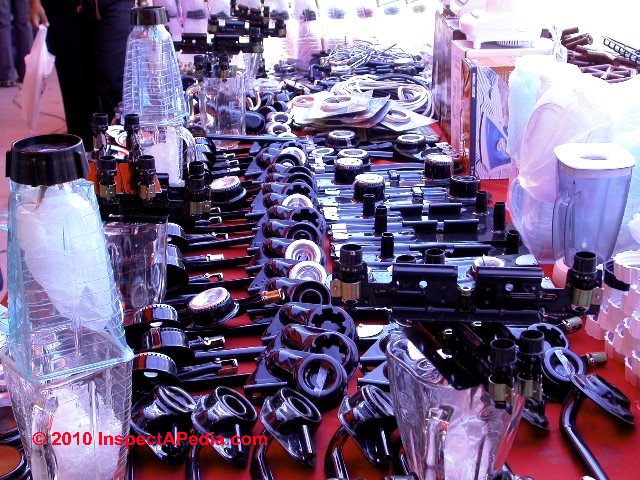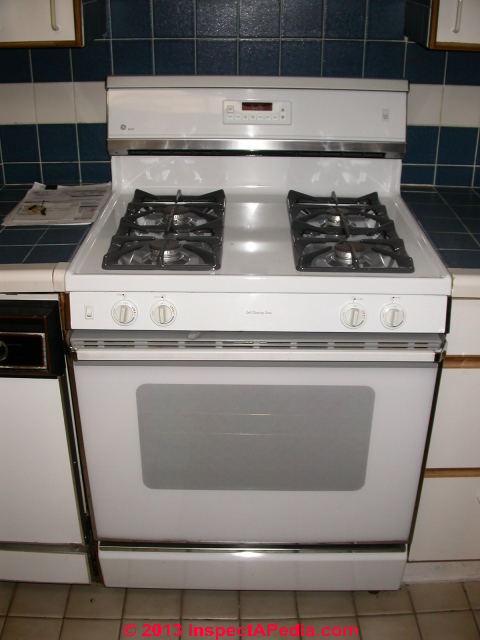 How to Convert a Heating Appliance from LP to Natural Gas
How to Convert a Heating Appliance from LP to Natural Gas
or from Natural Gas to Propane
- POST a QUESTION or COMMENT about gas fuel conversions: LP or "bottled gas" to piped-in natural gas service
LP to Natural Gas conversions or Natural Gas to LP fuel conversion procedures:
This article explains the procedure for converting from LP gas or "bottled gas" to natural gas or "piped in gas" at a building.
InspectAPedia tolerates no conflicts of interest. We have no relationship with advertisers, products, or services discussed at this website.
- Daniel Friedman, Publisher/Editor/Author - See WHO ARE WE?
How to Convert a Gas Appliance From Natural Gas to Propane (or vice versa)
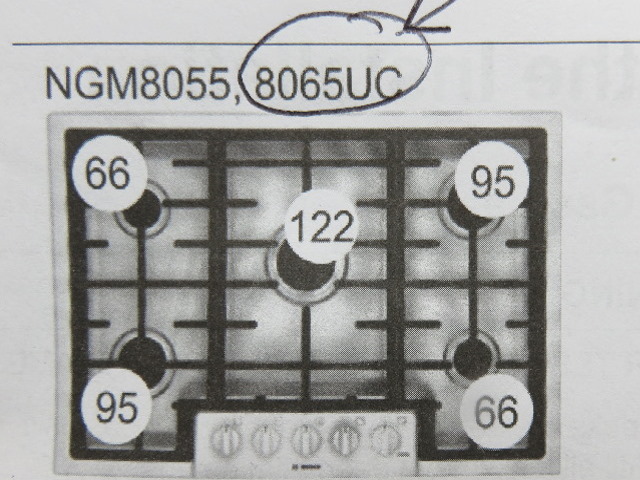 Watch out: Most manufacturers require that installation and fuel conversions shall be performed by a trained and qualified service technician.
Watch out: Most manufacturers require that installation and fuel conversions shall be performed by a trained and qualified service technician.
The technician should be sure to correctly identify the model number of your gas appliance so that s/he can follow the correct details of the manufacturer's instructions.
Photo: example nozzle sizes for different burners when converting a Bosch stovetop between LP and natural gas.
Article Contents
- GAS APPLIANCE CONVERT LP-to-NATURAL GAS
- TOOLS & SUPPLIES for GAS CONVERSION & COOKTOP INSTALLATION
- GAS APPLIANCE CONVERT REGULATOR NATURAL GAS-to-LP from Natural to Propane Gas - separate article
- CONVERT the GAS ORIFICES or spuds from Natural Gas to Propane - separate article
- CONVERT the BURNER VALVES or AIR SHUTTER from Natural Gas to Propane
- GAS FLAME COLOR CHECK
- CONVERT OVEN BURNER & THERMOSTAT from Natural Gas to Propane
- APPLIANCE COMPATABILITY to LPG, PROPANE vs NATURAL GAS
- TROUBLESHOOTING Q&A for Natural Gas to LP or Propane Gas Appliance Conversions
- GAS COOKTOP INSTALLATION into a countertop - separate article series describes piping connections, electrical connections, countertop preparation, countertop opening & clearances, testing for gas leaks, securing the cooktop to the countertop & final inspection & tests.
- GAS COOKTOP RANGE & OVEN REPAIR & MANUALS - includes gas conversion kit manuals
Five Steps in Converting a Gas Fueled Appliance From Natural Gas to Propane or LPG
To change a gas fired appliance of any sort between LPG and Natural Gas fuel there are at least all of these fuel system changes that are ** required ** in the appliance:
- The gas supply pressure to the appliance
(at it's shutoff, for example and thus ahead of the appliance's own regulator) must be regulated by a regulator at the building LPG or natural gas supply and must be within the range specified by the manufacturer - The gas regulator at or in the appliance
must be switched to the appropriate fuel: LPG or natural gas. Most appliance gas regulators can be converted in the field. For example in a Bosch unit I am working on the instructions have you remove a cap and invert a component inside the regulator, depending on which fuel you are using.
See CONVERT the GAS REGULATOR - The gas metering orifices or jets
are changed at each burner in the appliance. Natural gas and LP gas do not use the same orifice sizes to achieve the appliance's designed BTU rate at the burner(s). Just changing pressure won't do it and is dangerous. The manufacturer may refer to these parts as "spuds" or "orifices" or "metering jets".
See CONVERT the GAS ORIFICES - The air mix at the gas controls at the appliance
is changed to the appropriate rate for the fuel. For example in a Bosch gas range top that is delivered ready for natural gas, to convert to LP gas the instructions require the installer to rotate an adjustment screw (gently to a closed position in the case of this appliance) found at each of the individual burner controls on the appliance.
See CONVERT the BURNER CONTROLS or AIR SHUTTER
Some appliances such as a gas range that includes both a cook top and an oven will also require additional changes and adjustments at the oven.
See CONVERT OVEN BURNER & THERMOSTAT - Safety checks
for gas leaks & proper appliance adjustment and operation
The gas appliance conversion kit manufacturer will provide a sticker indicating that the appliance has been converted - in this case from natural gas (as shipped from the factory) to ready for use with LP gas (propane). Be sure that that identifying sticker is affixed next to the appliance model and serial number data tag.
These steps only describe the conversion of fuel between natural gas and propane for a gas appliance. A separate sequence of gas cooktop or gas appliance steps is provided in a separate article series beginning
Watch out: Converting a gas appliance is dangerous if not done correctly and in accordance with the manufacturer's instructions. Here are two typical manufacturer's gas conversion kit warning notices
This conversion kit shall be installed by a qualified service agency in accordance with the manufacturer’s instructions and all applicable codes and requirements of the authority having jurisdiction. If the information in these instructions is not followed exactly, a fire, explosion, or production of carbon monoxide may result, causing property damage, personal injury, or loss of life.
The qualified service agency is responsible for the proper installation of this kit. The installation is not proper and complete until the operation of the converted appliance is checked as specified in the manufacturer’s instructions supplied with the kit. - Whirlpool corporation citation below
This conversion kit must be installed by a qualified installer or service technician in accordance with these instructions. Installation must conform with local codes, or in their absence, with the latest edition of the National Fuel Gas Code, ANSI Z223.1.
Failure to follow instructions could result in serious injury or property damage. The qualified agency performing this work assumes responsibility for this conversion. - Rheem conversion instructions - Natural Gas to LP Gas, citation below
If you are not sure whether your building and its appliances are served by LP gas (bottled gas or liquid petroleum gas) or by natural gas (piped-in gas), see the descriptions of each of these types of heating fuel
at GAS PIPING, VALVES, CONTROLS.
Tools Needed for Gas Cooktop Gas Orifice Spud Conversion Between Natural Gas & LP / Propane
Tools listed by the manufacturer for converting between natural gas and LP gas or propane and for installing a gas cooktop or range will typically include a small-bladed screwdriver, a nut driver, and wrenches.
It's a rare installation job that goes like clockwork without encountering a surprise, as we will illustrate.
For example you may need a hammer and chisel if minor adjustments to wood obstructions intrude into the appliance opening, and you will certainly need both thread sealant designed for gas piping installation and a gas leak detector solution.
[Click to enlarge any image]
Above left are the manufacturer's instructions, slip joint pliers, a marker, a metric hex key set (more on this later), a small bladed screwdriver that fits the burner control knob air adjustment screws (more on this later), and a magnifying glass that let blind old guys read the stampings on the spuds or gas orifices.
You'll need a nut driver sized to match the spuds or orifices to be removed or installed along with a gas leak detector and thread sealant formulated for use on gas piping.
As the manufacturers all insist that gas appliances should be installed only by a qualified technician (or by a licensed installer as is required by building regulations in some jurisdictions) we know you'll have all of these tools and supplies, but it's nice to have them at hand.
For example, the nut driver for modern gas appliance spuds may be a size that you didn't have, or you may have nut drivers only in inch-dimensions and you may need to buy one in metric dimensions to avoid damaging the brass orifice spud.
LP Gas <-> Natural Gas Appliance Regulator Conversion - Example
This topic is now
at GAS APPLIANCE CONVERT REGULATOR NATURAL GAS-to-LP from Natural to Propane Gas
In an excerpt just below we illustrate removing the cap from the gas regulator for a Bosch gas cooktop in the NGM80 series. At below right the cap has been removed by unscrewing it from the regulator body. Close-up photos follow.
Typically the conversion between fuels requires simply the rotation, inversion, or adjustment of parts already present on the gas appliance.
See GAS APPLIANCE CONVERT REGULATOR NATURAL GAS-to-LP for details. from gas leaks.
Change the Gas Orifices (Spuds) to Convert between Natural Gas & LP Gas - Example
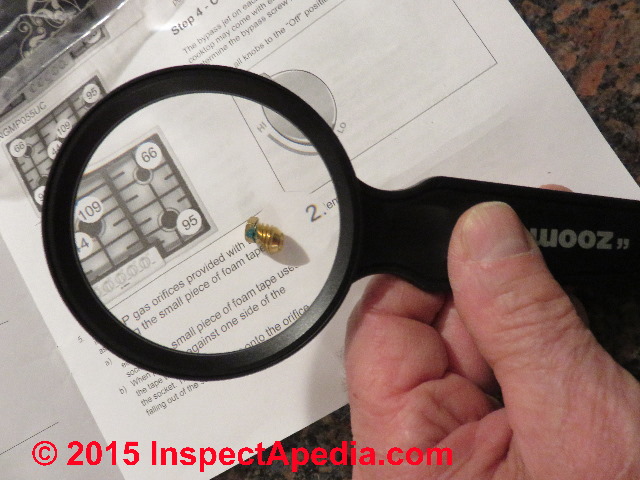 See CONVERT the GAS ORIFICES for complete details. A brief excerpt from that article is just below.
See CONVERT the GAS ORIFICES for complete details. A brief excerpt from that article is just below.
For most gas cooktops a threaded brass orifice or "spud" is used to meter gas at the proper flow rate at each burner. Gas flow rate, a combination of supply pressure and orifice diameter, determines the quantity of gas available at the individual burner and thus sets its BTU output rate or range.
The orifice diameter of these tiny little parts is different between natural gas and propane or LP gas. This means that you will need to change the orifice fittings to match the fuel you intend to use.
When converting an appliance from using a lower pressure natural gas fuel supply to a higher pressure LP or propane gas fuel supply, the new orifices will be smaller in diameter to accommodate the higher pressure of the fuel supply without releasing too much fuel too quickly.
Your appliance technician will have to select the proper orifices, remove existing orifices, and install the new ones in the right location following the conversion kit instructions from your appliance's manufacturer.
Watch out: leaving out this step or installing the wrong orifices is dangerous: the appliance won't work properly and you risk a fire or explosion.
How to Adjust the Top Burner Air Shutters or Air Supply to Convert between LP Gas and Natural Gas - Example
Some gas cook tops convert between Natural and LP gas at the Burners by turning or adjusting an air shutter (sketch at below left) while others require that you turn a screw adjustment inside or next to the burner control knob.
[Click to enlarge any image]
Here is an example of a convertible gas range burner top.
The valve hood (at left in the photo) is adjusted to an open or closed position depending on use with natural gas or LP gas.
Find and obtain the precise instructions from the manufacturer of your own appliance brand, model, and serial number in order to be safe.
Air Adjustment Required at Gas Cooktop Burner Controls to Convert Between LPG and Natural Gas - Bosch Cooktop Example
Next we need to adjust the individual gas burner control air mix at the burner control knobs.
Turn the burner control knobs to the "OFF" position before proceeding.
At above left we see the control knobs in place on the Bosch cooktop and at above right they've been removed and set aside. For Bosch gas cooktops there is a small air adjustment screw that needs to be set at each control knob position.
Depending on the cooktop model the screw may be found inside the cooktop adjacent to a solid-stem control knob shaft or the screw may be (almost impossible to see) down in the center of a hollow-stem control knob shaft itself (shown in photos below).
A rubber gasket intended to keep crud out of the center of the control knob shaft will make it impossible to see the adjustment screw - you'll locate it by feeling gently inside the control knob shaft with your long small bladed screwdriver.
You'll find that the screwdriver blade will insert about 1 1/2" into the hollow control knob stem, passing the rubber gasket, and finding the adjustment screw.
Gently turn the screwdriver to find the slot in the adjustment screw - it's a slot not a phillips-headed screw.
Which way to turn the adjustment screw: the details of this air adjustment will vary by manufacturer. For the Bosch cooktop we are installing here the company says that to convert from natural gas to LPG (propane) you will need to turn the screw less than one full turn clockwise to a "closed" position.
For our Bosch cooktop Bosch says you'll turn the screw just about 70 degrees clockwise (less than 1/4 of a turn) until the screw bottoms out. Your cooktop may have different specifications.
Watch out: Bosch warns that you must not use excessive force when turning the air adjustment screw or you can damage the assembly.
After setting all of the burner control air screws for the cooktop, replace the control knob and you've finished this step.
This sequence illustrates the conversion of a Bosch gas cooktop from natural gas to propane fuel. Other burner air shutter control adjustments for other cooktops and ranges are illustrated
at CONVERT the BURNER VALVES or AIR SHUTTER
When you have completed all of the modifications specified by the manufacturer to convert fuels you will typically have made three changes:
The gas regulator has been converted to LPG from natural gas (or vice versa)
The gas burner orifices or spuds have been changed out to insert orifices for the fuel being used (LPG in our case).
The gas burner air adjustment screw (or air adjustment shutter on some models) has been adjusted for the fuel being used (LPG in our case).
Gas Burner Flame Color Checks: How do we know if the gas regulator, orifices, and air supply are adjusted correctly?
What to Do if You Smell Gas Inside or Even Outside Near a Building
Immediate LP Gas or Natural Gas Safety Concerns
- Gas Odors: A gas leak can be indicated by gas odor such as in the utility area near appliances or elsewhere in the building.
From a safe location, call your gas company's emergency line and/or your fire department. The text provided here is a working draft and may be incomplete or inaccurate.
You should have your plumber test, repair, or replace any suspect gas controls or piping promptly. Replacement of a control itself should not involve significant expense. This repair should not be deferred. You should be sure that building occupants know if this or other unsafe conditions are present.
Inspect the Gas Flame for Proper Colour
[Click to enlarge any image]
The photo above shows the gas flame after a successful installation of our Bosch gas cooktop converted to burn propane. There is just a trace of yellow in the flame tips.
Our gas flame colour illustration shown immediately above, adapted from Bosch (2014),shows the properties of
- Unhealthy, mostly-yellow gas burner flames (top, check the gas regulator and air mix) that can occur on either LP (or propane) or natural gas burners
- Healthy yellow tips on outer cones of otherwise blue flames (center) characteristic of LP or propane gas burner flames
- Healthy soft blue flames of a natural gas burner
More stuff to check when looking at the gas flame
- Yellow and lazy gas flame may mean inadequate gas pressure or inadequate combustion air
- Unusually high gas flame may indicate excessive gas pressure (or wrong orifice)
- Gas flame making a popping noise when turned off and on
- Gas flame burning at the orifice
- Gas flame spilling out of the burner area of the appliance
Any of these indicate a possible malfunction of this equipment.
Watch out: Any of these LP gas , propane, or natural gas burner conditions is potentially very dangerous and needs prompt attention. You should have your utility company or service person check the appliance immediately.
More details and a longer list of gas burner or flame worries are
at GAS BURNER FLAME & NOISE DEFECTS
How to Adjust the Oven Burner & Thermostat to Convert between LP Gas and Natural Gas - Example
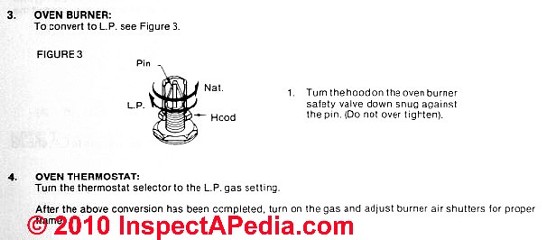
Here is an example of a convertible gas range pressure regulator.
The oven burner hood is adjusted to an open (Natural Gas) or closed (Propane) position depending on the fuel.
Find and obtain the precise instructions from the manufacturer of your own appliance brand, model, and serial number in order to be safe.
Additional steps may be needed for your appliance, such as adjusting air mixture at the burner for the proper flame.
Watch Out: failing to properly install, adjust, and vent a gas fired appliance can result in dangerous, even fatal carbon monoxide poisoning, gas leaks, a fire, or other dangerous conditions.
Natural gas and LP gas appliance compatibility
These two fuels are similar in that both are used to provide energy to home heating systems and other appliances but they have some different properties of weight, method of distribution, and chemistry. Most gas appliances are delivered already set up to use either natural gas or LP gas but not both.
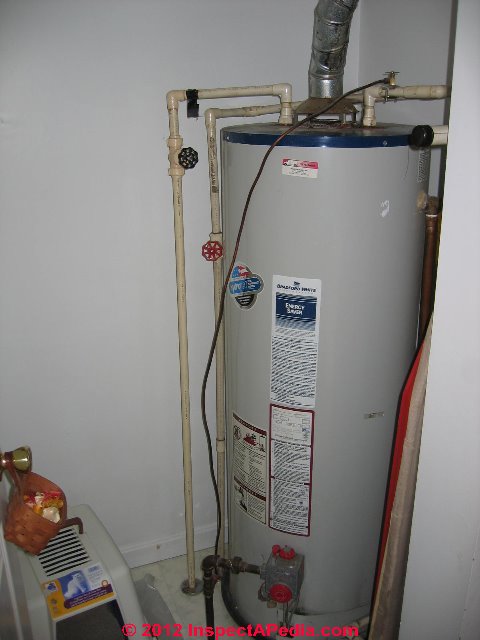 Most gas appliances can be converted from one fuel to the other - what is involved may be simply changing gas metering orifices in the equipment (for example at the burners on a stove) or it may also be necessary to change or adjust a gas regulator located inside the appliance.
Most gas appliances can be converted from one fuel to the other - what is involved may be simply changing gas metering orifices in the equipment (for example at the burners on a stove) or it may also be necessary to change or adjust a gas regulator located inside the appliance.
Do not hook up an LP gas-ready appliance to a natural gas supply nor can you connect a natural-gas ready appliance to an LP gas supply without reviewing and acting on the manufacturer's instructions for converting the appliance from one fuel to the other.
Watch Out: be sure that all gas-fired appliances in your building have been properly set up for the correct type of gas to be consumed.
Watch out: General safety warning: improper installation and even improper inspection and testing methods involving natural or "LP" gas can involve dangerous conditions and risk fire or explosion.
If you smell gas you should leave the building immediately and should do so without doing anything that could create a spark such as operating a light switch or telephone.
Do not connect an appliance set up for propane to a natural gas supply, and do not connect an appliance set up for burning natural gas to a propane gas supply without first making the required gas pressure and/or gas metering orifice adjustments.
Making either of this mistakes can lead to gas leaks, fire, explosion, or potentially fatal carbon monoxide poisoning.
Virtually every modern gas fired appliance installation manual contains instructions for setting up the appliance to burn the proper fuel: LP gas (liquid propane from a tank installed at the property) or natural gas (piped in gas provided from a local gas utility company).
The pressure provided by natural gas is different from propane - adjustments will be needed at every gas fired appliance in the home.
Usually this means either an adjustment made at each gas burner at a metering device or in some cases a part actually has to be changed (an orifice through which the gas passes).
On some appliances there may be a local gas regulator that also needs to be adjusted.
Where a gas burner metering device needs to be set properly for Natural Gas pressure or for LP gas pressure, the adjustment may be as simple as using a screwdriver or tool to turn the orifice from one position to another at each burner, or a part may need to be actually swapped out or exchanged.
Appliance installation instructions will include sketches of where these parts are found as well as directions for how to set the metering device or regulator for the proper fuel.
Where is natural gas or LP gas pressure regulated for a gas fired appliance:
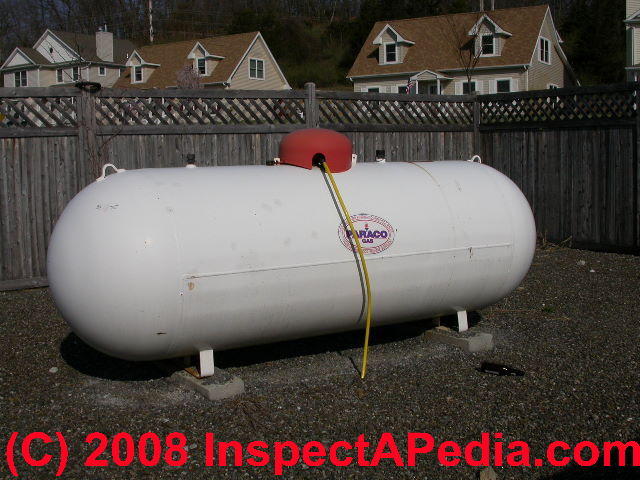 For LP Gas the pressure is regulated at the LP gas tank by a primary regulator and further pressure is matched to the requirements of the individual appliance by a regulator located at or in some cases inside the appliance such as a gas cooktop or gas clothes dryer or water heater.
For LP Gas the pressure is regulated at the LP gas tank by a primary regulator and further pressure is matched to the requirements of the individual appliance by a regulator located at or in some cases inside the appliance such as a gas cooktop or gas clothes dryer or water heater.
At some buildings, particularly with long gas line runs there may also be an intermediate or building gas pressure regulator, particularly if the LP tank is distant from the building.
And for some appliances such as gas ranges and ovens, additional gas flow regulation is performed by a special metering orifice right at the gas burner.
We illustrate these gas regulators and orifices as well as fuel conversion between LP gas and natural gas in this article.
On many gas fired appliances the only adjustment that is required is to change or turn/adjust the gas metering orifice at the appliance burner.
Critical safety warnings about changing between gas fuel types: LP to or from Natural Gas
Watch out: Do not hook up an LP gas-ready appliance to a natural gas supply. Do not connect a natural-gas ready appliance to an LP gas supply. First you must read and act on the manufacturer's instructions for converting the appliance from one fuel to the other. It is virtually always the case that some equipment adjustments and changes are necessary to switch between natural gas and propane gas.
Testing for gas leaks after hookup is complete is another important safety step that should not be skipped.
The proper setup of gas burning appliances is very important since failure to set the appliance for the proper gas type can result in very dangerous, even fatal carbon monoxide production from improper combustion.
If your natural gas supplying company or plumber who is doing the hookup has not already offered to do so, ask them to go through the home identifying every gas-burning appliance, determine exactly what changes are needed, and make them before the appliances are again turned on with the new fuel supply.
Follow the appliance setup and gas fuel type adjustment instructions in the appliance installation manual provided by the manufacturer.
If you cannot find the installation manual for your gas fired water heater, stove, furnace, boiler, or other gas fired appliance, make a note of the appliance name, model number, and serial number, and contact the manufacturer directly for these critical instructions.
The actual conversion from LP to or from Natural gas at the appliance itself is usually quite easy, but doing it properly is essential for safety.
Also see GAS REGULATORS & APPLIANCE / HEATER CONTROLS
and GAS REGULATORS for LP TANKS.
These two gas fuels are similar in that both are used to provide energy to home heating systems and other appliances but they have some different properties of operating gas pressure, weight, method of distribution, and chemistry.
Most gas appliances are delivered already set up to use either natural gas or LP gas but not both. However some older gas appliances such as the gas stove shown in our photo (above/left) may not be convertible between gas fuels.
Watch out: if the fuel at your building is not the fuel for which the gas fired appliance is set-up, the appliance must be converted to match the fuel you will be using. That conversion involves several steps and is not simply a pressure adjustment.
Most modern gas appliances can be converted from one fuel to the other - what is involved may be simply changing gas metering orifices in the equipment (for example at the burners on a stove) or it may also be necessary to change or adjust a gas regulator located inside the appliance.
For example as JR, an industry manager familiar with gas pressures pointed out, these two fuel gases operate at different pressures. In residential appliances
- Natural Gas system pressure: Natural gas operates at a nominal pressure of 7” WC (about 0.253 psi)
- LPG or Liquid Propane Gas system pressure: LP gas or propane operates at a nominal pressure of 11” WC (about 0.397 psi)
- Actual NG or LPG gas pressures vary: [Note: the exact pressure you see in the building at an appliance may vary from these numbers depending on the gas distribution piping system size, diameter, number of appliances served, number of appliances operating, regulator adjustment, and other factors.
See GAS REGULATORS & APPLIANCE / HEATER CONTROLS
and GAS REGULATORS for LP TANKS.
See GAS PRESSURES LP vs NATURAL GAS for a table showing the range of variation in LP gas pressure in the tank at various temperatures. - Ed.]
The following additional examples show again where adjustments are required on a typical gas stove to convert between LP gas and Natural Gas. These examples are for a Glenwood Sunray gas range produced by the Glenwood Range Company. These adjustments should be made by a trained appliance installer or service technician.
Our photo (left) shows gas appliance parts and controls for sale at an open air market held on Tuesdays in San Miguel de Allende, Mexico. But as we warn below, installing or modifying parts on a gas appliance can be dangerous if you don't know what you are doing.
Watch Out: these gas fuel type conversion examples are intended only for the purpose of general understanding of the type of changes that may be needed at a gas fired appliance.
Be sure to consult with the manufacturer or the installation and service manual to obtain and follow the exact gas fuel conversion steps for your particular gas appliance.
Otherwise your gas appliance is likely to be unsafe. To obtain the proper installation and service manual for your gas appliance you will need the product name, model number, code numbers/letters, serial number, and the date of installation or manufacture.
How to Install a Gas Cooktop into the Countertop & Connect Gas Piping & Electrical Power
This topic has been expanded & moved to GAS COOKTOP INSTALLATION
Watch out: If your gas cooktop came from the factory set-up for natural gas and your fuel source is propane (or vice versa) you should complete all of the gas conversion steps before proceeding to install the cooktop into the countertop.
See GAS APPLIANCE CONVERT LP-to-NATURAL GAS if you need to make this changeover.
Troubleshooting Converted Gas Appliances From LP to Natural Gas or Vice Versa
Reader Question: Can I use natural gas in a LPG oven,after boosting its pressure 2000 pa to 2800 pa and without changing its nozzles?
Can I use natural gas in a LPG oven,after boosting its pressure 2000 pa to 2800 pa and without changing its nozzles?
and
Riaz said:
Can I use natural gas in a LPG oven,after boosting its pressure up to 2800 pa and without changing its nozzles?
These questions were originally posted at GAS PRESSURES LP vs NATURAL GAS 18 Feb 2015 Anonymous
Reply: no.
Anon and Riaz:
Watch out: changing the gas supply pressure to a figure outside the standards specified by the manufacturer simply to try to switch between LPG and natural gas won't work and is dangerous.
To change a gas fired appliance of any sort between LPG and Natural Gas fuel there are at least all of these fuel system changes that are ** required ** in the appliance:
- The gas supply pressure to the appliance (at it's shutoff, for example and thus ahead of the appliance's own regulator)
must be regulated by a regulator at the building LPG or natural gas supply and must be within the range specified by the manufacturer - The gas regulator at or in the appliance must be switched to the appropriate fuel:
LPG or natural gas. Most appliance gas regulators can be converted in the field. For example in a Bosch unit I am working on the instructions have you remove a cap and invert a component inside the regulator, depending on which fuel you are using. - The gas metering orifices or jets are changed at each burner in the appliance.
Natural gas and LP gas do not use the same orifice sizes to achieve the appliance's designed BTU rate at the burner(s). Just changing pressure won't do it and is dangerous. - The air mix at the gas controls at the appliance is changed to the appropriate rate for the fuel.
For example in a Bosch gas range top that is delivered ready for natural gas, to convert to LP gas the instructions require the installer to rotate an adjustment screw (gently to a closed position in the case of this appliance) found at each of the individual burner controls on the appliance.
In addition the manufacturers typically require that the conversion of a gas fueled appliance between LPG and Natural gas should be performed by a trained service technician who will also perform certain pressure and leak tests that are essential to avoid a fire or explosion.
And depending on where you live, such as in the U.S. in Massachusetts, the conversion of an appliance between LPG and Natural Gas is required by law to be performed by a trained and qualified service technician.
Example LP Gas Range Pressure Requirements
Finally, just a couple of data points as examples, again borrowing from one of Bosch's Gas Cooktop installation guides (NGM80 series using model NGM8065UC),
- The minimum gas supply pressure must be 1" water column (249 pa) above the manifold pressure printed on the appliance data plate
- The maximum gas supply pressure must not exceed 14" water column (3487 pa or 34.9 Millibars)
- The natural gas pressure ** for this specific appliance, yours will be different ** should be 7" water column (1744 pa) [ the instructions say 14.9 millibars which looks to me like a possible error as 14.9 millibars = about 6" of water column - ed.]
- The Propane or LP or LPG gas pressure ** for this specific appliance, yours will be different ** should be 11" water column (2740 pa or 17.4 millibars)
Range Cooktop Gas Conversion Citations
- Bosch, "Gas Cooktops Installation Manual, NGM Gas Cooktops (NGM30, NGM50, NGM 56, NGM80, NGM86, NGMP65)", (2013), Bosch, 1901 Main St., Suite 600, Irvine CA 92614, Tel: 800-944-2904, Website: www.bosch-home.com
- Bosch, "LP Gas Conversion Kit Installation Manual , NGM Gas Cooktops (NGM30, NGM50, NGM 56, NGM80, NGM86, NGMP65)", (2014), Bosch, 1901 Main St., Suite 600, Irvine CA 92614, Tel: 800-944-2904, Website: www.bosch-home.com
- Bosch, "Gas Cooktops Use and Care Manual, NGM5055, NGM8055, NGM8065, NGMPO55, NGM5655, NGM8655, NGM8665, NGMP655", (11/13), Bosch, 1901 Main St., Suite 600, Irvine CA 92614, Tel: 800-944-2904, Website: www.bosch-home.com
What can go wrong if wrong gas size orifices are installed?
When converting a 90,000BTU furnace from Natural Gas to LP Gas (Propane), what can go wrong if the contractor installs the wrong size gas orifices?
For example, if the proper LP Gas orifice is supposed to be size 1.15 (.0453 diam.) ..what can happen if he installed size 54 (.0550 diam.)?
Specifically, can it cause excessive soot and eventually plug the heat exchanger?
This question was posted originally
at HEATING SYSTEMS and also at the link cited just below. (Apr 3, 2014) Mark Christopher
Reply:
Mark
See GAS PRESSURES LP vs NATURAL GAS where in the FAQs we addressed this when that post was first seen.
Reader Question: converting an LP gas fired Kiln & Furnace to Natural Gas
I have a kiln and furnace in a foundry. I have used LP gas at 15 lbs pressure through an initial 1/4 inch tubing into a 3/4 inch tube that divides into two 3/4 inch open pipes that serve as dual burners, when squirrel cage blowers are incorporated. These allow for the melting of bronze at 2200 degrees F.
I have converted to natural gas. With the same set-up and "standard pressure" (whatever that is?) adequate volume of gas and necessary btu is not being obtained. What should the pressure be to obtain comparable cubic feet of natural gas - compared to propane? I now can obtain the necessary btu when using a small hand torch and natural gas with atmospheric air.
But the volume is inadequate for the furnace/kiln combination. Your help shall be appreciated. This Q&A originally appeared
at GAS BTUH, CUBIC FEET & ENERGY 4/26/2014 Ben
Reply:
Watch out: You should SHUT OFF YOUR EQUIPMENT IMMEDIATELY if you have not already done so. It is unsafe.
Ben, thanks for the interesting & important LP-NG conversion question.
We know that it's critical for both function and safety to get the pressures, orifices and metering devices, and equipment air mixtures correct when converting between LP gas and natural gas.
www.propane101.com - a website supported by propane dealers offers technical guidance, from which I quote:
Natural gas is a much lower pressure gas than propane and converting the appliance to one or the other gases requires that the differing pressure is compensated for. In other words, connecting a natural gas appliance to a propane piping system will result in appliance malfunction and possibly danger.
The reason for this is because natural gas orifices are larger than propane orifices strictly because of gas service pressure. In this case, the higher pressure gas flowing through a larger orifice will result in more gas through the burner and likely, more flame...an unnecessarily large flame.
Conversely, trying to use a propane appliance with natural gas will likely result in a very small flame or no burner flame at all because of the lower pressure gas and the smaller orifice. This is the underlying purpose of an appliance conversion from propane to natural gas or from natural gas to propane. Additionally, appliances cannot be converted from electricity to propane, or vice-versa.
Look for an LP to NG Conversion Label on the Equipment
If your equipment does not include a label indicating that it CAN be converted between fuels, you should not assume that such conversions will work and are safe. Generally a "conversion" changes both metering devices that meter the gas fuel and the air mixture adjustments as well. An improper air mixture adjustment, particularly in gas fired equipment, can produce fatal carbon monoxide gas.
What Components May Need to Be Changed Out or Adjusted on a Gas Fuel Conversion Job?
To convert fuels in a gas fired appliance the propane experts I cited list more parts than you may realize that may need to be changed, including (besides what I've already listed) burners, burner tubes, regulators, orifices, safety controls, combustion air supply equipment, and venting of flue gases - equipment, chimneys, power vents, etc.
Furthermore, some of these must be adjusted or changed-out in concert with one another - in balance:
- the gas burner
- the air shutter (controls mix of combustion air with fuel)
- the gas metering devices (often jets or orifices)
Should you Just Replace the Heating Equipment rather than Convert?
The opinion of the propane fellows (and women) is that for some equipment that was not *designed* to be convertible between fuels, you'd be better off buying new equipment intended to work with the new fuel.
But before I'd consider such a step, I'd identify the brand and model of the foundry kiln and furnace you mentioned, find the manufacturer, and give them a call to ask advice. I'd be surprised if a gas fired equipment manufacturer produced products only for one fuel.
To review the science of LP and natural gas
see GAS BTUH, CUBIC FEET & ENERGY and also see Brinzea (2010) in our citations.
LP to Natural Gas or Natural Gas to LP Appliance Conversion References
- Also see GAS COOKTOP RANGE & OVEN REPAIR & MANUALS
- BOSCH LP GAS CONVERSION KIT INSTALLATION MANUAL (2019) [PDF] for gas cooktops Models: NGM5056UC, NGM5656UC, NGM8056UC, NGM8656UC, NGMP056UC, NGMP656UC, NGM8046UC, NGM8646UC
- BOSCH LP GAS CONVERSION KIT INSTALLATION MANUAL (2018) [PDF] for gas cooktops Models: NGM5056UC, NGM5656UC, NGM8056UC, NGM8656UC, NGMP056UC, NGMP656UC, NGM8046UC, NGM8646UC
- BOSCH LP GAS CONVERSION KIT INSTALLATION MANUAL [PDF] (2017) for Gas Cooktops Model NGM5056UC, NGMP056UC, NGM5656UC, NGM8056UC, NGM8656UC, NGMP656UC
- Bosch, "Gas Cooktops Installation Manual, NGM Gas Cooktops (NGM30, NGM50, NGM 56, NGM80, NGM86, NGMP65)", (2013), Bosch, 1901 Main St., Suite 600, Irvine CA 92614, Tel: 800-944-2904, Website: www.bosch-home.com
- Bosch, "LP Gas Conversion Kit Installation Manual , NGM Gas Cooktops (NGM30, NGM50, NGM 56, NGM80, NGM86, NGMP65)", (2014), Bosch, 1901 Main St., Suite 600, Irvine CA 92614, Tel: 800-944-2904, Website: www.bosch-home.com
- Bosch, "Gas Cooktops Use and Care Manual, NGM5055, NGM8055, NGM8065, NGMPO55, NGM5655, NGM8655, NGM8665, NGMP655", (11/13), Bosch, 1901 Main St., Suite 600, Irvine CA 92614, Tel: 800-944-2904, Website: www.bosch-home.com
- GAS REGULATOR ADJUSTMENT PROCEDURE [web article]
- Harper-Wyman GAS REGULATOR CONVERSION INSTRUCTIONS [PDF] Harper-Wyman Company, Subsidiary of Oak Industries, Inc., 3600 Thayer Court, Suite 110, Aurora IL 60504 USA, Tel: 708-978-8000
See pp. 5-6 describing converting a Harper-Wyman gas regulator between LP gas and Natural gas, in these instructions for the Thermador Professional Pro dual-fuel gas ranges. These gas regulator conversion instructions pertain to other appliances as well. - Venera Brinzea, Maria Mitu, Codina Movileanu, Adina Musuc and Domnina Razus, "Expansion Coefficients And Normal Burning Velocities Of Propane-air Mixtures By The Closed Vessel Technique", University of Bucharrest, (2010), Analele Universatati Bucuresti, Department of Physical Chemistry
4-12 Regina Elisabeta Blvd, District 3, Bucharest
phone: +40'21'3143508; fax: +40-21-3159249
p
ISSN: 1220-871X
e
ISSN: 1844-0401, ARS DOCENDI PUBLISHING HOUSE
Sos. Panduri 90, District 5 Bucharest
phone/fax: +40'21'4102575
e'mail: arsdocendi@yahoo.com
Abstract:
The normal burning velocities of propane'air mixtu res were calculated from the expansion coefficients and the cubic law constants of flame propagation in the early stage of closed vessel explosions, using the adiabatic compr ession model.
The experiments were made in a spherical vessel with central ignition in various initial conditions: pressure within 0.3÷1.3 bar, temperature within 298÷423 K, propane concentration within 2.80÷6.22 vol.%. The expansion coefficients were computed for the adiabatic isobar ic combustion, assuming equilibrium is reached in the flame front.
The normal burning velocities are compared with literature data and with normal burning velocities calculated from the same cubic law constants, using the isothermal compression model - Whirlpool Corporation, "Propane Conversion Kit Safety", retrieved 4/28/14, original source: http://www.whirlpoolcomfort.com/Upload/20562901.pdf
- PropaneCarbs.com, "Tri Fuel Natural Gas & Propane Conversion Kits, More Information About Conversion Kits ... for Generators, Welders, Concrete Sws, Floor Cleaners, Man Lifts", Tel: 1-877-425-8383, Email: info@propanecarbs.com, Website: http://www.propanecarbs.com, retrieed 4/28/14, original source: http://www.propanecarbs.com/tri_fuel_kits.html
- Propane101.com, "Converting Gas Appliances", Email: webmaster@propane101.com, website: http://www.propane101.com, retrieved 4/28/2014, original source: http://www.propane101.com/lpgasapplianceconversions.htm
Notice: as of the retrieval date, and regarding authority, the "Propane 101" website does not name authors, provides no contact information, no address. - Rheem Corporation, "Conversion Instructions, Natural Gas to LP Gas", FaxBack 1506 These fuel conversion instructions are limited to Manufactured Housing products only. Retrived 4/28/14, original source: http://www.rheem.com/docs /FetchDocument.aspx?ID=1c3868ba-1cdc-4e3f-8aec-b7c7a4a1d137
- Also see more manuals and conversion kit instructions
at GAS COOKTOP RANGE & OVEN REPAIR & MANUALS
...
Reader Comments, Questions & Answers About The Article Above
Below you will find questions and answers previously posted on this page at its page bottom reader comment box.
Reader Q&A - also see RECOMMENDED ARTICLES & FAQs
Where do I get the right natural gas spuds for my Samsung stove burners?
I am trying to find four Natural Gas Orifices or Spuds for my five burners Samsung which had been changed over to LP. The Natural G Orifices were lost or thrown away. I am in such need for these little spuds On 2021-02-10 by Diann
Answer by (mod) -
Diann
The spuds or gas orifices for your Samsung are model-specific, so you'll want to contact Samsung directly.Be sure to have your Samsung model number and also its serial number as sometimes even within model design changes may have been made.
How do I reverse the GPS adapter on my Samsung gas appliance?
My instructions indicated that I need to "reverse the GPS adapter" Samsung NX60*875*S* How is the adapter identified? On 2021-02-01
by joe
Suggestion by (mod) -
I'd need to find the parts explosion and look, Joe, but typically there is a component inside the regulator that is simply flipped over between NG and propane.
Let's identify the Samsung appliance (perhaps it's a Samsung gas range ) and get a hold of the IO manual - that ought tot be clear enough.
How do you convert a propane stove to natural gas ?
How do you convert a propane stove to a natural gas stove? On 2020-12-09 by Carolee
Answer by (mod) -
Carolee
To convert a stove between propane and natural gas you would follow the procedures given above on this page,
adjusted, of course, for your specific stove model, as the exact location of gas orifices that need to be changed, regulator to be adjusted or modified, and any adjustments at burner controls will be stove brand and model dependent.
Watch out: some stoves and other gas appliances cannot be coveted between fuel types.
That is a second reason why it's smart to get a copy of the installation and operation manual for your specific stove brand and model.
With the manual in hand you'll have contact information for the manufacturer - needed to order the exacty-correct gas orifices that need to be changed in the appliance.
Watch out: take care to follow the manufacturer's instructions and warnings since making a mistake risks a gas leak, fire, explosion, or worse. You'll see that the manufacturer may advise against doing the conversion yourself - doubtless because of the dangers and liabilities involved.
What parts would i need to change from LP to natural gas for a Whirlpool stove? Mod# WFG320M0BW0
What parts would i need to change from LP to natural gas for a Whirlpool stove? Mod# WFG320M0BW On 2020-12-06 by Tim
Answer by (mod) -
You will need to convert the regulator itself which sometimes requires simply flipping over or changing an internal part or on some appliances a regulator might need to be replaced.
In addition there will be a gas orifice for each burner that needs to be replaced.
There may also be a need to replace or adjust each gas burner control.
Is it difficult to change from natural gas to propane or vice versa ?
How hard is it to change this out from liquid propane to natural gas when an older model stove On 2020-11-20 by Robert Newman
by (mod)
Robert
You ask a perfectly fair question but not one that a reasonable person can answer for a stranger.
Was easy for a trained heating service technician could be very difficult for a homeowner who's never done the job before.
If you can find the correct parts and if the original parts are not terribly corroded in place and can be removed without stripping the fittings it may be a fairly easy job for some folks.
How do I convert a Maytag to natural gas?
Have purchased a maytag stove that was used on LP and I need to convert to natural gas!
Found advice and kit but was told that jets/ports for oven and broiler are discontinued? how to convert a Maytag to natural gas - On 2020-09-28 by Charles L. Nemons
Reply by (mod) -
Charles
Sometimes we can find a part for an older appliance by posting a request on one of the auction sites that will then notify you when someone offers that part for sale, but for gas stove conversion orifices I'm not optimistic; most people (except me) don't hang on to the LP or Natural gas jets or orifices that they removed when converting the appliance.
So if you can't find the exactly-right parts from a manufacturer or supplier you may be stuck with re-selling your used Maytag LP fueled stove; if you do re-sell it be sure you make clear to the buyer that it's set up for use just with LP.
Can a Zanussi cooker be changed from propane to natural house gas?
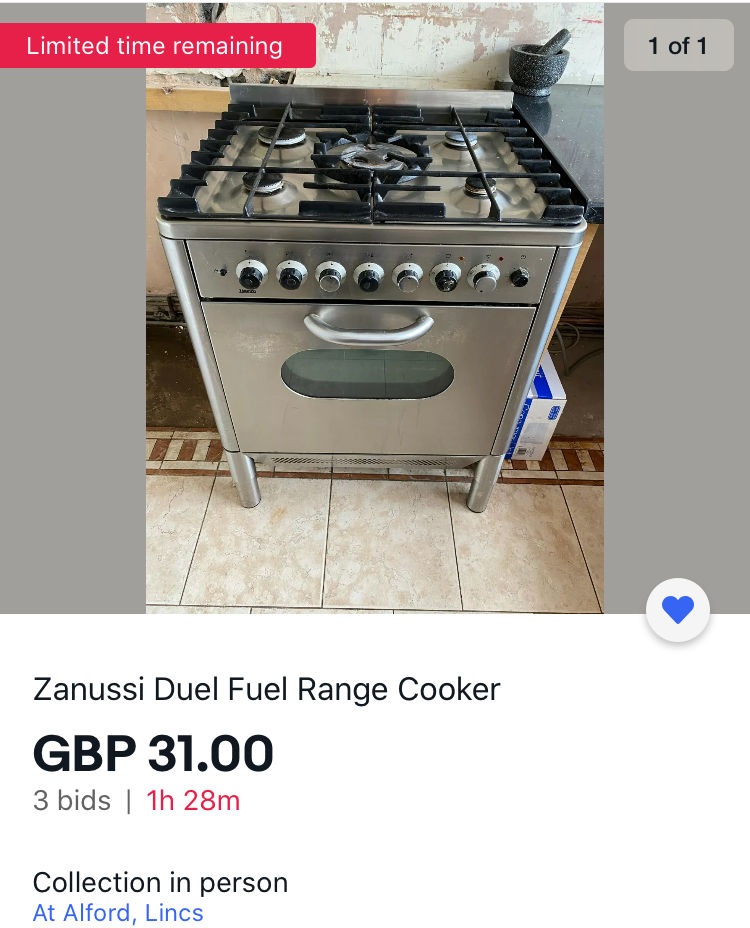 Can a Zanussi cooker be changed from propane to natural house gas?
Can a Zanussi cooker be changed from propane to natural house gas?
Thanks On 2020-08-30 by Mark
Answer by (mod) -
Mark,
You don't give the Zanussi gas range cooker model.
Here is the ZANUSSI DUAL FUEL GAS RANGE MANUAL [PDF] for models ZCG63010BA ZCG63010WA ZCG63010XA - as a dowloadable PDF.
On p. 22 you'll see a reference to
The Rapid injector is used as a pressure test point.
1. Connect the pressure gauge to the Rapid injector.
2. Examine the supply pressure by turning the Rapid burner and one other burner fully on, and lighting them.
The [gas] pressure must be:
a) 20 mbar for Natural Gas
b) 29 mbar for LPG, butane only
c) 37 mbar for LPG, propane only.
making evident that those models can be set up for any of those three fuels.
Can a lpg cooker be converted into natural gas
Can a lpg cooker be converted into natural gas On 2020-03-15 by David
by (mod) -
Most LPG appliances but not all can be converted to natural gas; contact the manufacturer of your cooker to ask for a gas conversion kit and follow their instructions. Typically you change out one or more gas orifices and change or modify the regulator.
Should I go natural gas or propane?
Should I go natural gas or propane. When is one the better value based on price and btu demand? On 2015-01-13
by Larry
by (mod) -
Larry there is no simple "right answer" to your question since equipment, fuel prices and availability are so variable in different countries and within those countries.
In most jurisdictions where natural gas - piped in from a utility - is available people make use of that resource.
You might want to take a look at comparative BTU costs found at https://inspectapedia.com/heat/Current_Heating_Cost_Table.htm
But keep in mind that equipment costs, initial installation costs, costs to buy or rent an LP tank, costs for piping and meters, etc. should be economic factors of interest to many property owners.
What can go wrong if the contractor installs the wrong size gas orifices?
When converting a 90,000BTU furnace from Natural Gas to LP Gas (Propane), what can go wrong if the contractor installs the wrong size gas orifices? For example, if the proper LP Gas orifice is supposed to be size 1.15 (.0453 dia) ..what can happen if he installed size 54 (.0550 dia)? Specifically, can it cause excessive soot and eventually plug the heat exchanger? On 2014-02-19 by Mark Christopher
On 2014-04-28- by (mod) -
Mark this is beyond my expertise but my guess is that you should
Watch out: if the orifice is too large the air-gas mixture would be incorrect and sooting would be likely - and dangerous as there is an increased risk of carbon monoxide production - a potentially fatal mistake.
If this was done in your case you should shut down the heater immediately, consult the manufacturer for proper instructions, and have the system leaned, including the chimney or vent, properly set-up, and checked for safe operation.
Other hazards are listed in the article above, some of which are very serious.
...
Continue reading at GAS COOKTOP INSTALLATION or select a topic from the closely-related articles below, or see the complete ARTICLE INDEX.
Or see GAS APPLIANCE LP-NG CONVERSION FAQs - questions & answers posted originally on this page
Or see these
Recommended Articles
- GAS APPLIANCE CONVERT LP-to-NATURAL GAS
- GAS APPLIANCE CONVERT NG-to-LP
- GAS BURNER FLAME & NOISE DEFECTS
- GAS BURNER SOOT CAUSE & CURE
- GAS COOKTOP RANGE & OVEN REPAIR & MANUALS
- GAS LEAK DETECTION, LP / NG
- GAS PRESSURES LP vs NATURAL GAS
- GAS REGULATORS & APPLIANCE / HEATER CONTROLS
- GAS REGULATOR ADJUSTMENT PROCEDURE
- GAS REGULATOR CONVERSION NG-LP
- GAS REGULATORS for LP TANKS
- GAS REGULATOR TEST PROCEDURES
- GAS REGULATORS, TWO STAGE
- GAS LP & NATURAL GAS SAFETY HAZARDS
- GAS LP & NATURAL GAS PRESSURES
Suggested citation for this web page
GAS APPLIANCE CONVERT LP-to-NATURAL GAS at InspectApedia.com - online encyclopedia of building & environmental inspection, testing, diagnosis, repair, & problem prevention advice.
Or see this
INDEX to RELATED ARTICLES: ARTICLE INDEX to GAS APPLIANCES, PIPING, CONTROLS
Or use the SEARCH BOX found below to Ask a Question or Search InspectApedia
Ask a Question or Search InspectApedia
Try the search box just below, or if you prefer, post a question or comment in the Comments box below and we will respond promptly.
Search the InspectApedia website
Note: appearance of your Comment below may be delayed: if your comment contains an image, photograph, web link, or text that looks to the software as if it might be a web link, your posting will appear after it has been approved by a moderator. Apologies for the delay.
Only one image can be added per comment but you can post as many comments, and therefore images, as you like.
You will not receive a notification when a response to your question has been posted.
Please bookmark this page to make it easy for you to check back for our response.
IF above you see "Comment Form is loading comments..." then COMMENT BOX - countable.ca / bawkbox.com IS NOT WORKING.
In any case you are welcome to send an email directly to us at InspectApedia.com at editor@inspectApedia.com
We'll reply to you directly. Please help us help you by noting, in your email, the URL of the InspectApedia page where you wanted to comment.
Citations & References
In addition to any citations in the article above, a full list is available on request.
- Bosch, "Gas Cooktops Installation Manual, NGM Gas Cooktops (NGM30, NGM50, NGM 56, NGM80, NGM86, NGMP65)", (2013), Bosch, 1901 Main St., Suite 600, Irvine CA 92614, Tel: 800-944-2904, Website: www.bosch-home.com
- Bosch, "LP Gas Conversion Kit Installation Manual , NGM Gas Cooktops (NGM30, NGM50, NGM 56, NGM80, NGM86, NGMP65)", (2014), Bosch, 1901 Main St., Suite 600, Irvine CA 92614, Tel: 800-944-2904, Website: www.bosch-home.com
- Bosch, "Gas Cooktops Use and Care Manual, NGM5055, NGM8055, NGM8065, NGMPO55, NGM5655, NGM8655, NGM8665, NGMP655", (11/13), Bosch, 1901 Main St., Suite 600, Irvine CA 92614, Tel: 800-944-2904, Website: www.bosch-home.com
- Venera Brinzea, Maria Mitu, Codina Movileanu, Adina Musuc and Domnina Razus, "Expansion Coefficients And Normal Burning Velocities Of Propane-air Mixtures By The Closed Vessel Technique", University of Bucharrest, (2010), Analele Universatati Bucuresti, Department of Physical Chemistry 4-12 Regina Elisabeta Blvd, District 3, Bucharest phone: +40'21'3143508; fax: +40-21-3159249 p ISSN: 1220-871X e ISSN: 1844-0401, ARS DOCENDI PUBLISHING HOUSE Sos. Panduri 90, District 5 Bucharest phone/fax: +40'21'4102575 e'mail: arsdocendi@yahoo.com
- Whirlpool Corporation, "Propane Conversion Kit Safety", retrieved 4/28/14, original source: http://www.whirlpoolcomfort.com/Upload/20562901.pdf
- PropaneCarbs.com, "Tri Fuel Natural Gas & Propane Conversion Kits, More Information About Conversion Kits ... for Generators, Welders, Concrete Sws, Floor Cleaners, Man Lifts", Tel: 1-877-425-8383, Email: info@propanecarbs.com, Website: http://www.propanecarbs.com, retrieed 4/28/14, original source: http://www.propanecarbs.com/tri_fuel_kits.html
- Propane101.com, "Converting Gas Appliances", Email: webmaster@propane101.com, website: http://www.propane101.com, retrieved 4/28/2014, original source: http://www.propane101.com/lpgasapplianceconversions.htm
Notice: as of the retrieval date, and regarding authority, the "Propane 101" website does not name authors, provides no contact information, no address. - Rheem Corporation, "Conversion Instructions, Natural Gas to LP Gas", FaxBack 1506 These fuel conversion instructions are limited to Manufactured Housing products only. Retrived 4/28/14, original source: http://www.rheem.com/docs /FetchDocument.aspx?ID=1c3868ba-1cdc-4e3f-8aec-b7c7a4a1d137
- U.S. Energy Information Administration - eia.doe.gov/
- U.S. Environmental Protection Agency - epa.gov/solar/energy-and-you/affect/natural-gas.html
- At Natural Gas.Org www.naturalgas.org/environment/naturalgas.asp#emission you’ll find a table of combustion products
- At geocities.com/rainforest/6847/report1.html is an interesting and detailed though not “neutral” report on the components and contaminants in the combustion of natural gas. You’ll see a long long list of emissions products, but look again – most of the contaminant levels listed are in the picograms.
- apvgn.pt/documentacao/iangv_rep_part1.pdf lists the components in natural gas exhaust from vehicles
- The Need Project, Manassas, VA: need.org/needpdf/infobook_activities/SecInfo/NGasS.pdf
- Kroschwitz, Jacqueline I., and Mary Howe-Grant (eds.). "Gas, Natural." In Encyclopedia of Chemical Technology. 4th ed., vol. 12. New York: John Wiley and Sons, Inc., 1993.
- Tussing, Arlon R., & Bob Tippee. The Natural Gas Industry: Evolution, Structure, and Economics. 2nd ed. Tulsa, OK: PennWell Publishing, 1995.
- Thanks to reader E Leal for suggesting the addition of details about how to convert gas burning appliances from propane to natural gas or from natural gas to propane. 8/4/09
- Thanks to reader JR for discussing LP and natural gas operating pressures and leak detection safety, October 2010.
- Glenwood Range Company, Customer Service, 435 Park Ave., Delaware OH 43105, 614-363-1381, Glenwood-Sunray Service Center: 215-682-4211.
- In addition to citations & references found in this article, see the research citations given at the end of the related articles found at our suggested
CONTINUE READING or RECOMMENDED ARTICLES.
- Carson, Dunlop & Associates Ltd., 120 Carlton Street Suite 407, Toronto ON M5A 4K2. Tel: (416) 964-9415 1-800-268-7070 Email: info@carsondunlop.com. Alan Carson is a past president of ASHI, the American Society of Home Inspectors.
Thanks to Alan Carson and Bob Dunlop, for permission for InspectAPedia to use text excerpts from The HOME REFERENCE BOOK - the Encyclopedia of Homes and to use illustrations from The ILLUSTRATED HOME .
Carson Dunlop Associates provides extensive home inspection education and report writing material. In gratitude we provide links to tsome Carson Dunlop Associates products and services.


